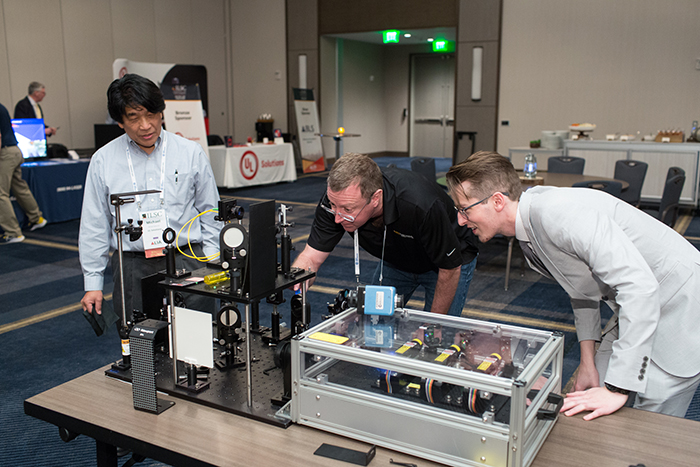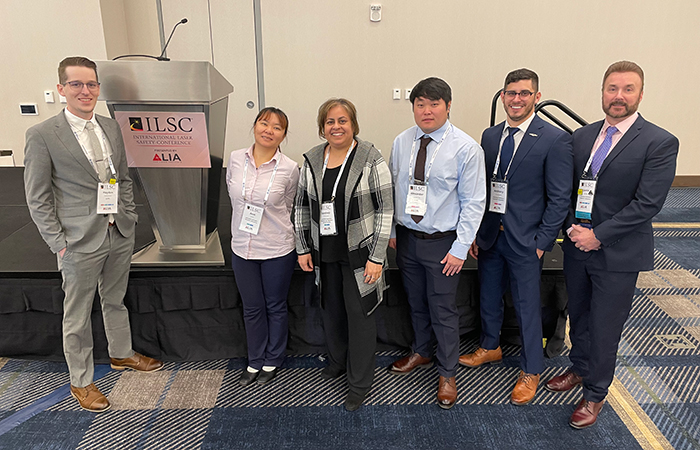NIF Laser Safety Protocols Laid a Foundation for Historic LLNL Ignition Shot
June 7, 2023
 LLNL Deputy Laser Safety Officer (DLSO) Hayden Johnson (right) shows the NIF&PS educational outreach 3-laser demo to fellow attendees at the 2023 International Laser Safety Conference in Portland, Oregon. Credit: LIA-The Laser Institute
LLNL Deputy Laser Safety Officer (DLSO) Hayden Johnson (right) shows the NIF&PS educational outreach 3-laser demo to fellow attendees at the 2023 International Laser Safety Conference in Portland, Oregon. Credit: LIA-The Laser Institute When a Lab principal investigator told NIF&PS Work Planner (WP) Sandeep Bansal about what was thought to be a simple plan to install a new laser system for research, she immediately knew it would be more complicated than just firing the laser.
NIF has a rigorous, carefully crafted set of safety regulations that protects laser workers, requiring a safety review by a team consisting of an industrial safety professional, an industrial hygienist, an environmental specialist, a fire protection engineer, the facility manager, and an LLNL laser safety officer.
“I have to stop, pause, take a step back and say, ‘Let’s go through this and see what you need,’ ” Bansal said during the 2023 International Laser Safety Conference (ILSC).
That long-established level of attention to laser safety over the years has contributed to the groundbreaking research at the world’s largest and most energetic laser, where LLNL reached the historic achievement of fusion ignition in December 2022 (see “The Age of Ignition”).
And as with many conferences since that milestone, ignition was top of mind when ILSC 2023 convened in late February in Portland, Oregon, the first in-person gathering for the group since before the COVID-19 pandemic shutdown started in March 2020.
 The team representing LLNL at the 2023 ILSC from left: DLSO Hayden Johnson, Industrial Hygienist Anni Mai, NIF&PS Work Planner Sandeep Bansal, NIF Health Physicist Alex Yang, Deputy Radiation Safety Officer Anthony Novello, and LLNL/ NIF Laser Safety Officer Jamie King. Not pictured: Tammy Ma. Credit: Jamie King
The team representing LLNL at the 2023 ILSC from left: DLSO Hayden Johnson, Industrial Hygienist Anni Mai, NIF&PS Work Planner Sandeep Bansal, NIF Health Physicist Alex Yang, Deputy Radiation Safety Officer Anthony Novello, and LLNL/ NIF Laser Safety Officer Jamie King. Not pictured: Tammy Ma. Credit: Jamie King ILSC 2023 general conference chair Jamie King, who is LLNL’s Laser and Nonionizing Radiation (NIR) Safety Program lead, presented an overview of the safety requirements needed for NIF’s optical and laser systems that produced the historic shot.
“The biggest laser safety challenge that we have is that it's a massive facility, (with) numerous access points,” King said. “We don't have one way to get in and one way out.”
He noted there were also three different types of operations, “diagnostic alignment and testing, rod shots where we’re firing the pre-amplifier modules, and system shots where we dump all the energy from the capacitors into the flashlamps.”
In addition, “most people inside of NIF are not laser workers, so we lean heavily on engineering controls, and we have to train them (workers),” he said. “Lasers and other diagnostics are always being added to the facility.” He added that a laser hazard analysis, required for any new installation, can take more than six months to complete.
 Jamie King congratulates the R. James Rockwell Jr. Educational Achievement Award recipient, Dr. David Sliney, a pioneer in laser safety, for outstanding contributions to laser safety education. Credit: LIA-The Laser Institute
Jamie King congratulates the R. James Rockwell Jr. Educational Achievement Award recipient, Dr. David Sliney, a pioneer in laser safety, for outstanding contributions to laser safety education. Credit: LIA-The Laser Institute Bansal said that in one instance, a new laser required the installation of a new ventilation system and also needed to be set up in a way that satisfied California’s seismic safety standards. And even when “the only thing left for them to do was to turn it on,” she said, “we make sure the entire safety team walks it one more time.”
One of the plenary talks that opened the conference was delivered by LLNL’s Tammy Ma, Advanced Photon Technologies (APT) Program Element leader for High-Intensity Laser High Energy Density (HED) Science. Her talk was titled “Creating a Star on Earth: Ignition and Where Lasers Are Taking Us in the Future of Fusion Energy.”
“With that demonstration of scientific energy gain on the NIF, we’ve got to start moving,” said Ma, who also serves as the lead for LLNL’s Inertial Fusion Energy (IFE) Institutional Initiative said. “And if we don't, other countries, including our adversaries, are very interested in this technology. And so there's also this unprecedented momentum in public and private spheres that we should harness.”
IFE will still be a “multi-decade endeavor,” Ma said. “It will not be easy. And it will create enormous innovation not only in laser technology, but in targets and additive manufacturing, in computation, and artificial intelligence.
“We need to bring it all together now,” she continued. “And so it’s a really exciting time. Fusion energy really does offer a long-term vision for enduring global climate and energy security. And we're so excited to be working on it.”
More Information:
“New Generation of Laser Safety Officers Convene for DOE Workshop,” NIF & Photon Science News, November 16, 2022
“Laser Safety Book Draws from LLNL, NIF Expertise,” NIF & Photon Science News, April 21, 2021
—Benny Evangelista
Follow us on Twitter: @lasers_llnl



